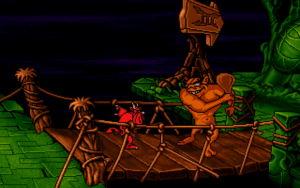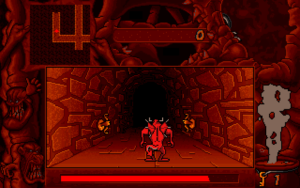Litil Divil compared to Dark Souls
I’ve mapped out as much of maze 4 as I can currently access. There are two challenge rooms available. One involves pieces of floor disappearing in a regular pattern, and the regularity makes it predictable enough that I’ve managed to beat it. However, it opened up no new territory, instead rewarding me with a tennis racket. The other involves leaping from stone to stone as they float down a lava river, and I guess the rest of the level must be on the other side of that — the rest of the challenges, the exit, and most particularly the save room.
And not being able to access the save room is a real problem! Without it, I have to restart from the save room on level 3 every time I launch the game, and that’s a significant way back in the maze, separated from the exit by a lot of walking and a lot of traps, followed by the two bridge battles punctuating every level’s exit and entrance. I’m remembering now why my approach to this game back in the day turned from binging it to playing it once in a while, between other things. It just requires a lot of repeated activity. Very likely the trampoline room where I got stuck before had similar issues.
I’m tempted to say things like “Of course, this was how things were in the old days. In the immediate wake of the coin-op model, games didn’t really have a lot of content, and instead were designed to make you re-experience lots of it repeatedly to produce the sort of total play time that players demanded, something that’s become less of an issue in recent years due to the content glut of the indiepocalypse”. But then I think of Dark Souls. That, and games like it, also feature lots of long runs through the same passages repeatedly whenever you die. And it felt a lot more tolerable there — why? The sense of progress is a big factor, I suppose. In a soulslike, your losses from death aren’t complete. Even if you lose a huge stash of Souls, you still have any inventory you collected on the way, as well as any progress in killing non-respawning enemies or other permanent changes in world state. Litil Divil provides no such mercy. But also, I think the greater variation in the architecture makes it easier to bear Dark Souls runs. Corrodors in Litil Divil are all the same, modulo traps and the occasional skeleton. Variation, even just small changes in the slope of the ground or the texture of the walls or the degree of light, helps to make places feel like places, rather than points in a homogenous mass. And being able to look around and think “I know where this is” helps give a sense of progress to the whole thing.
I suppose the way to get through this is to adopt the meditative mindset, ritualize the passage through the maze and abandon attachment to result. That’s gotten me through games before. It’s just that it’s a frame of mind that conflicts with that produced by the challenge rooms that are the actual goal of each sally.
 Comments(0)
Comments(0)
